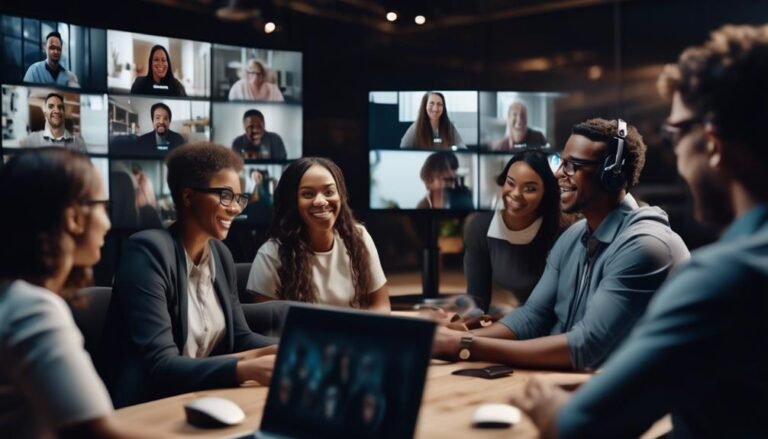Implementing Recognition Strategies for Better Workplace Relationships
Struggling to foster better relationships at work? The key may lie in your recognition strategies. Effective recognition can significantly enhance workplace morale and create a positive environment where everyone feels valued. By appreciating both big wins and small, everyday contributions, trust and camaraderie among team members are built. Simple gestures like personalized thank-you notes or public acknowledgments can make a significant difference. Start recognizing those around you and watch workplace relationships transform.
Understanding the Role of Recognition
Recognition plays a transformative role in the workplace. It taps into psychology, offers various types, and enhances team cohesion.
The Psychology Behind Recognition
Recognition satisfies fundamental human needs for appreciation and belonging. When you acknowledge someone’s efforts, it activates the brain’s reward system, releasing dopamine and fostering motivation. This nurtures a positive emotional state, leading to increased job satisfaction.
Psychological research shows that consistent recognition can reduce stress and improve mental well-being. To better understand your current stress levels, consider taking a burnout test from BrainManager. Fostering such an environment nurtures trust and strengthens relationships, making work more enjoyable and less stressful.
Types of Recognition in Workplace
Formal Recognition: Structured and often public, such as awards, certificates, and bonuses helps solidify a culture of appreciation.
Informal Recognition: This type of recognition is spontaneous and personal, like verbal praise or thank-you notes. It’s often more frequent and can be highly impactful.
Social Recognition: Sharing achievements on internal networks or bulletin boards enhances visibility and collective pride.
Monetary Recognition: Bonuses, raises, and gift cards are tangible rewards that often hold significant value.
Benefits of Recognition for Team Cohesion
Recognition fosters a culture of inclusivity and cooperation. When you acknowledge effort, it builds a supportive environment where team members feel valued.
Regular recognition boosts morale and loyalty, which translates into higher productivity and reduced turnover rates. It cultivates a positive cycle where recognition begets more hard work and commitment.
Teams that recognize each other’s efforts communicate more effectively and demonstrate higher levels of trust and collaboration. This collaborative spirit is key to achieving shared goals.
Developing Recognition Programs
Creating effective recognition programs involves focusing on key components, enhancing peer recognition, and utilizing appropriate tools and platforms to foster a positive workplace culture.
Key Elements of Effective Programs
- Effective recognition programs should have clear criteria and objectives.
- Ensure transparency in the nomination and selection process. Establish both formal and informal recognition methods to address various achievements.
- Frequency and consistency are crucial.
- Recognize employees regularly, not just during major events. Tailor the recognition methods to fit different departments and roles, ensuring they feel personal and meaningful.
- Employee involvement and feedback help refine the program.
- Consider implementing surveys or feedback sessions to understand what works best for your team.
Incorporating Peer Recognition
Peer recognition enhances camaraderie and boosts morale. Encouraging employees to recognize each other fosters a supportive environment. Implement simple, easy-to-use methods for peer recognition, such as shout-out walls or nomination systems. Train staff on giving effective recognition to promote genuine and specific acknowledgments. Acknowledge peer-to-peer recognition publicly during meetings or newsletters to reinforce its value. Creating opportunities for informal peer recognition can strengthen bonds and enhance teamwork, creating a more cohesive workplace dynamic.
Recognition Tools and Platforms
Digital tools and platforms streamline the recognition process by facilitating easy sharing of appreciation among employees. Platforms like Bonusly, Kudos, or Slack apps integrate seamlessly with other workplace systems, making recognition a seamless part of daily operations. These tools offer customization features, allowing for personalized recognition that can be tailored to individual preferences, enhancing the impact of awards and messages.
Additionally, many platforms provide analytics features to track participation and identify trends, which is valuable for continuously improving your recognition program. Gamification elements such as leaderboards and point systems can make recognition more engaging and motivating for employees, fostering a more dynamic and appreciative workplace culture.
Communicating Appreciation
Recognizing and appreciating employees effectively involves personalizing your messages, timing them appropriately, and ensuring managers are well-trained in recognition tactics.
Personalizing Recognition Messages
A personalized message can make someone feel truly valued. Tailor your recognition to individual achievements and characteristics. Address the person by their name and mention the specific actions or behaviors you’re appreciating.
Consider preferences. Some may prefer public recognition, while others might value a private note or email. Personal touches like a handwritten note can go a long way. Avoid generic messages. They can seem insincere and undermine the recognition effort.
Explore additional ways to express your gratitude through memorable gestures. One effective method is to personalize eCards with Punchbowl, bringing a personal touch that mimics the traditional look and feel of paper cards, enhancing the sincerity of your recognition efforts.
Timing and Frequency of Recognition
Timing is key when expressing appreciation. Acknowledge achievements as soon as possible after the event. Delayed recognition can lessen its impact. Immediate feedback not only reinforces positive behavior but also shows you’re paying attention.
Frequency matters too. Recognize consistently, but avoid overdoing it to the point where it feels routine. Balance is crucial to maintain sincerity and impact. Ensure that recognition aligns with significant milestones or exceptional performance rather than everyday tasks.
Recognition Training for Managers
Managers play a critical role in fostering a culture of appreciation. Provide them with training on effective recognition strategies. Equip them with tools and techniques to identify and acknowledge employee contributions. Encourage managers to recognize both individual and team efforts.
Training should cover various forms of recognition, from verbal praise to tangible rewards. Emphasize the importance of genuine and specific feedback. Help managers understand the value of regular check-ins and how they can use these opportunities to reinforce positive performance.
Overcoming Challenges
Implementing recognition strategies can be tricky. You’ll need to address common pitfalls, ensure fairness, and regularly measure and adjust your efforts.
Avoiding Common Pitfalls
One common mistake is inconsistent recognition. If some employees feel overlooked, this can breed resentment. Establish a structured and regular system for acknowledging achievements.
Another pitfall is focusing only on big accomplishments. Regularly appreciate small wins, too. This keeps morale high and shows that you notice everyday efforts.
Keep communication transparent. If the criteria for recognition are unclear, you risk misinterpretation and disengagement. Clear, well-documented processes can help everyone understand how and why recognition happens.
Ensuring Equity and Fairness
Fairness is crucial in recognition. Perceived biases or favoritism can severely damage relationships. Develop clear criteria and ensure that these criteria apply equally to everyone. Incorporating DEI training in the workplace can help managers recognize and mitigate unconscious biases, ensuring a fair and inclusive recognition process.
Collect feedback often. This helps you identify and correct any perceived inequities. Use anonymous surveys to encourage honest opinions.
Training managers in unbiased recognition practices can also promote fairness. They should be aware of unconscious biases and ensure their recognition is based on objective performance metrics.
Measuring Impact and Making Adjustments
Track the effectiveness of your recognition strategies using metrics such as employee satisfaction scores, turnover rates, and productivity levels. Data can highlight what’s working and what isn’t.
Regularly review and adapt your strategies based on this data. Hold periodic reviews to understand trends and make necessary adjustments.
Seek direct feedback from employees about their feelings regarding the recognition process. Keeping an open dialogue ensures that the system evolves to meet everyone’s needs and stays relevant.
Conclusion
Implementing effective recognition strategies can transform workplace relationships by fostering a culture of appreciation and inclusivity. By recognizing both significant and everyday contributions, trust and camaraderie among team members are strengthened. Utilizing various types of recognition, from formal awards to informal thank-you notes, and incorporating tools and training ensures a consistent and meaningful approach. Addressing common pitfalls and ensuring fairness through DEI training promotes a supportive environment. Regularly measuring and adjusting these strategies based on feedback helps maintain their relevance and impact, leading to a more cohesive and productive workplace.







